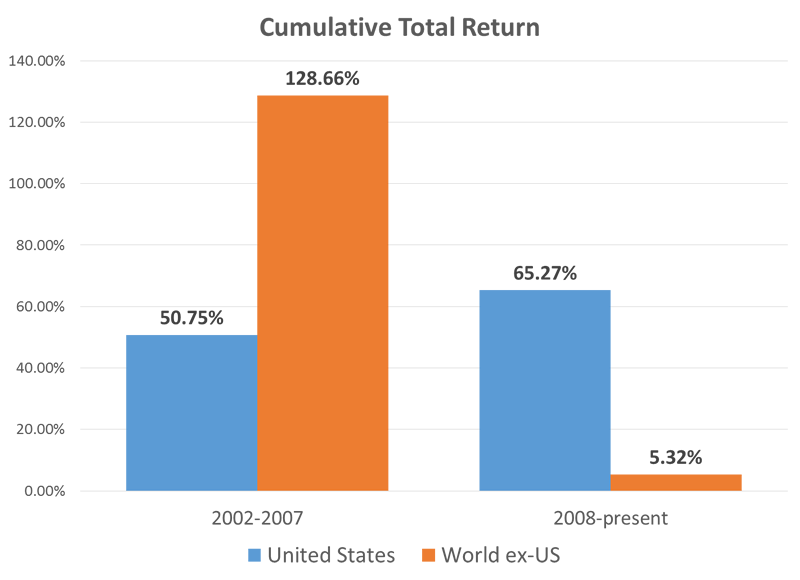Forget Emerging Markets THIS is Where You Should Invest
Post on: 19 Июль, 2015 No Comment

Posted by Wealth Wire — Wednesday, May 18th, 2011
Published 05/13/2011 — 09:00 *Originally published on StreetAuthority.com and re-published with permission.
By Steven Orlowski
Many investors wish they had invested earlier or more substantially in one or more of the BRIC countries: Brazil, Russia, India and China. In the mid-1990s the writing was on the wall that China and other emerging markets were headed for bigger and better things. But that message was overlooked by many retail investors and investment advisers.
The asset-allocation models that most brokerage firms recommend today have changed little over the years. A standard Growth model portfolio is 70% stocks and 30% bonds and cash, just like decades ago. The portfolio is further divided with 60% going to domestic stocks and 10% to foreign stocks. The majority of the foreign allocation is usually in developed economies in Europe, Australia and Asia. A small portion might be invested in emerging markets.
It is true that years ago countries such as China were unstable politically and economically. For some, they were too risky to invest in very heavily, or at all. But as conditions improved and as these countries began to demonstrate significant growth and exert an influence over the world economy. it should have been common practice to increase the allocation to emerging markets. But this has not been the case. Asset-allocation models are essentially the same. It is a shame to realize that many investors who followed the generic recommendations of their brokers and brokerage firms missed out on a more than a decade of profitable investing in emerging markets.
Here’s some statistics to consider:
The MSCI USA Index. which measures large and mid-cap equity performance, grew 0.86% per year for the 10 years ending May 10, 2010. That’s where 60% of a Growth investor’s portfolio was invested. Not much growth there.
The MSCI EAFE Index . an index of developed foreign markets, averaged 2.48% in the same period. Better, but not quite keeping up with inflation (which averaged about 3% during that time).
Now let’s consider the emerging markets:
You may feel like calling your adviser and asking why you weren’t invested in emerging markets. But all is not lost. There’s the potential for plenty of growth still to come in the BRIC countries, it likely just won’t be as robust as the past 10 years.
More important, there is a new crop of countries that are emerging into investable economies. These are called the frontier markets. The frontier markets include countries from Latin America, Africa, Eastern Europe and the Middle East. Examples of specific countries are South Africa, Turkey, Nigeria and Argentina (some have already moved South Africa to the emerging market category, renaming the BRIC countries the BRICS).
Many of the countries considered to be frontier markets are experiencing significant growth economically and politically and are building thriving economies. Many are also still too risky to invest in individually, however. As with China years ago, it can be difficult to find reliable information on companies within these markets. But as with the emerging markets, you needn’t buy individual stocks to potentially experience above-average returns — you can simply invest in the regions.
Here are a few funds to consider:
a. Claymore/BNY Mellon Frontier Markets ETF (NYSE: FRN ) — this exchange-traded fund (ETF) provides exposure to, among others, Egypt, Colombia, Kazakhstan, Chile, Poland, Lebanon, Peru and Oman.
b. Market Vectors Africa ETF (NYSE: AFK ) — This ETF provides exposure to both South Africa and North Africa, including Morocco, Nigeria and Egypt.
c. PowerShares MENA Frontier Countries (Nasdaq: PMNA ) — This ETF provides exposure to Kuwait, Jordan, the United Arab Emirates, Morocco and Oman.
d. Morgan Stanley Frontier Emerging Markets (NYSE: FFD ) — this is a closed-end fund that invests in the Middle East and Asia but also in countries such as Jamaica, Trinidad & Tobago and several Eastern European countries including Bulgaria and the Ukraine.
Although there is overlap among these funds, they each invest a bit differently and together provide a broad diversification across frontier markets. Make sure you know in which regions and countries a fund is invested because it’s easy to accidentally concentrate in a specific area without complete knowledge of a fund’s diversification.
There are other options to consider for frontier markets, such as country-specific ETFs. The Market Vectors Vietnam ETF (NYSE: VNM ) is an example. These funds invest exclusively in one country and are certainly worth considering. But remember: the more specific the focus of an investment, the greater the risk.
There are also traditional mutual funds that invest in frontier markets, such as the Templeton Frontier Markets A (Nasdaq: TFMAX ). But beware of fees. TFMAX is an actively-managed fund that has a 5.75% sales charge when you buy it. This compares quite unfavorably with the nominal commission you’ll pay to buy the ETFs mentioned above through a discount broker. TFMAX also has annual expenses of 2.08%, which also compares unfavorably with the ETFs. (Of the ETFs, the highest expense ratio is 0.83%.)
Action to Take —> Consider investing in the frontier markets today. Do this with a long-term time horizon, and do so with an understanding of potential volatility, i.e. short-term losses, in exchange for long-term gains. You should also do your own due diligence before investing in any of these funds.
Bottom line. Build an early foundation in these regions. Over time you can focus money in specific countries and particular companies, but you should get started before the potential triple-digit growth passes you by.
+3














